Spectre GCR Manual Manuals - Atari Documentation Archive
Spectre GCR Manual Manuals - Atari Documentation Archive
Spectre GCR Manual Manuals - Atari Documentation Archive
Create successful ePaper yourself
Turn your PDF publications into a flip-book with our unique Google optimized e-Paper software.
Hard Disks and <strong>Spectre</strong><br />
Note that it isn't exactly even - for instance, you start at 30,004,<br />
not 30,000.<br />
To the operating system, these are all completely different drives<br />
(say, C:, D:, E:, and F:). Only at the lowest level do the drives come<br />
together on the mechanism. The hard disk handler does this.<br />
When we ask for sector #1 of drive C:, we get physical sector #1 of<br />
the drive. And when we ask for sector #1 of drive D, we get the first<br />
physical sector of the D: "partition", #lO,002, off the drive. Similarly,<br />
asking for the first sector of the F: partition gives us sector #30,004. See<br />
how they're all put on one drive together?<br />
There's a place where the "offsets" for each partition are kept;<br />
that's the first sector of the hard disk. It's also called the "partition<br />
table" and "boot sector". The data for the Hard Disk menu (starting<br />
sector # and size, and type) comes from here.<br />
Okay, shortly after <strong>Atari</strong> did this, Supra and other people came<br />
out with huge hard disks, compared to <strong>Atari</strong>'s 20 megabyte unit.<br />
Given that we were stuck with 16 megabyte partitions because of the<br />
GEMOOS typo, the most that a hard drive could hold was four 16<br />
megabyte partitions - 64 megabytes total. Supra and JCD were already<br />
selling 130 megabyte units!<br />
So, Willie Brown and Mark White up at Supra came up with a<br />
new partitioning scheme. (Yup, I'm just name dropping). You could<br />
have up to 12 partitions per drive. And eventually they let you put up<br />
to 32 megabytes per partition, with the stipulation that you only go<br />
bigger than 16 megabytes if the use for it wasn't GEMOOS (e.g., wasn't<br />
anything in ST native mode). The <strong>Spectre</strong> is a perfect example.<br />
So, what we do to make the <strong>Spectre</strong> hard disk compatible is take<br />
one, or more, of the hard disk's partitions, and first, mark it so GEM<br />
never looks at it again. (For GEM to look at it would crash GEM, just as<br />
reading <strong>Spectre</strong> format floppies crashes GEM). Next, we "stamp"<br />
Macintosh formatting information on it - boot sectors, blank directory,<br />
and so forth. Then, we're all set; the partition is ready.<br />
As for you, next time you reboot your ST, that partition will have<br />
disappeared from your Desktop in ST mode (depending on certain<br />
things). If there was a disk icon hooked to that former GEM partition,<br />
you'll find it either doesn't work anymore ("drive doesn't exist") or it<br />
now hooks to the next available GEM partition, if there is one (e.g., if<br />
95



![Atari TT030 1.44 Megabyte Floppy Drive Installation Manual [1991]](https://img.yumpu.com/50770166/1/169x260/atari-tt030-144-megabyte-floppy-drive-installation-manual-1991.jpg?quality=85)
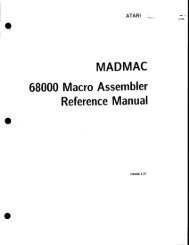

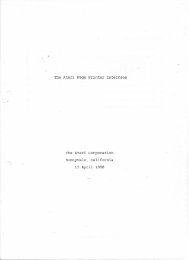
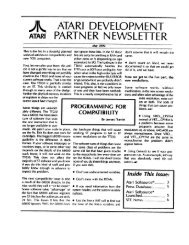
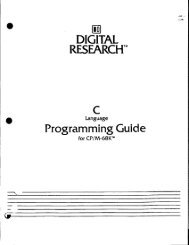
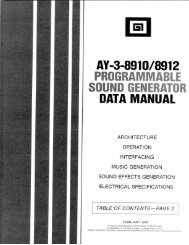
![Atari SM124 Service Manual P/N 483-303A (MT-9) [undated]](https://img.yumpu.com/48032932/1/184x260/atari-sm124-service-manual-p-n-483-303a-mt-9-undated.jpg?quality=85)
![Atari ST System-on-Chip in VHDL (Author: Lyndon Amsdon) [undated]](https://img.yumpu.com/47154349/1/190x245/atari-st-system-on-chip-in-vhdl-author-lyndon-amsdon-undated.jpg?quality=85)
![XBoot - The Boot Manager [1991] - Atari Documentation Archive](https://img.yumpu.com/44024401/1/190x135/xboot-the-boot-manager-1991-atari-documentation-archive.jpg?quality=85)
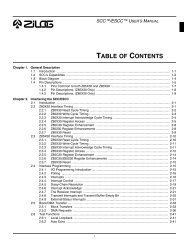
![Atari Megafile 30 & 60 Service Manual (RLL) [undated]](https://img.yumpu.com/41201963/1/189x260/atari-megafile-30-60-service-manual-rll-undated.jpg?quality=85)
![Atari Mega ST2/ST4 Schematic Rev 9 C100166 [Feb 19, 1987]](https://img.yumpu.com/41157604/1/184x260/atari-mega-st2-st4-schematic-rev-9-c100166-feb-19-1987.jpg?quality=85)

